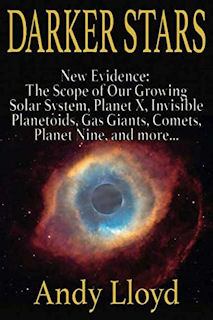"The newly found companion, HD 3651B, is 16 times further away from HD 3651 than Neptune is from the Sun. HD 3651B is the dimmest directly imaged companion of an exoplanet host star. Furthermore, as it is not detected on the photographic plates of the Palomar All Sky Survey, the companion must be even fainter in the visible spectral range than in the infrared, meaning it is a very cool low-mass sub-stellar object. Comparing its characteristics with theoretical models, the astronomers infer that the object has a mass between 20 and 60 Jupiter masses, and a temperature between 500 and 600 degrees Celsius. It is thus ten times colder and 300 000 less luminous than the Sun. These properties place it in the category of cool T-type brown dwarfs." (10)
Andy Lloyd's Dark Star News Archive 2006-7

Dwarf survives in stellar furnace
"Until now, astronomers believed something as small, in relative terms, as a brown dwarf could not emerge unscathed from immersion in the fiery furnace of a dying star.
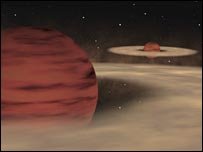
"We've discovered a small failed star called a brown dwarf lying next to another star called a white dwarf and the two are orbiting each other in a tiny orbit of two hours," Dr Matt Burleigh, a co-author of the paper and an astronomer at the University of Leicester, UK, told BBC News.
"We've found something 55 times more massive than Jupiter that has survived being swallowed by a red giant; can something smaller, like a known extrasolar planet, also survive?"" (1)
Discovery of the Nearest L Dwarf: The Intrinsically Faintest Object at Visual Wavelengths Known Beyond Our Solar System
"The purpose of CTIOPI is to discover and characterize overlooked stars and brown dwarfs in the vicinity the Sun. Objects are scrutinized by measuring their positions (and wobbles), their brightnesses and colors, and by taking spectroscopic fingerprints to examine their atmospheric composition. The estimated "missing" population of solar neighborhood members is expected to be composed primarily of very low mass stars with spectral type M (known as red dwarfs), and objects of spectral types L (like DEN 0255-4700) and T, many of which are actually brown dwarfs with too little mass to start long-term thermonuclear reactions. Such objects shine feebly, glowing only because of energy leaking out since their gravitational formation, many billions of years ago." (2)
Brown Dwarf Pair found in Interstellar Space
"...While they have similar masses to many of the giant planets discovered beyond our Solar System (the largest weighs in at 14 times the mass of Jupiter and the other is about seven times more massive), they are not thought to be true planets either. "We are resisting the temptation to call it a 'double planet' because this pair probably didn't form the way that planets in our Solar System did," said co-researcher Valentin Ivanov of the European Southern Observatory (ESO) in Santiago, Chile. The two objects have similar spectra and colours, suggesting that they formed at the same time about a million years ago. They are separated by about six times the distance between the Sun and Pluto, and can be found in the Ophiuchus star-forming region some 400 light years away." (3)
Brown dwarfs form during star conflict
There are many brown dwarfs in the galaxy, possible as many as there are stars. Some are found orbiting parent stars, others moving freely through interstellar space. It's been difficult for astronomers to work out under what circumstances such a variety of these failed stars formed. New computer simulations of young star systems interacting have given us a potential solution; that within the chaos of clashing proto-planetary discs, brown dwarfs emerge, with their own planetary systems! (4)
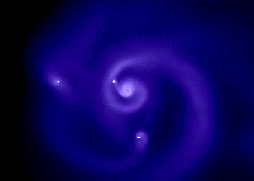
One can see how the sheer variety of brown dwarfs observed in nature could have resulted from such cataclysmic events. In our own star system's case, for instance, the Sun may have been born in a stellar nursery in close proximity to another star. As the planets formed, the two systems could have rubbed up against one another, ejecting whole chunks of the disc into the outer solar system, or into interstellar space. This might explain the anomalous shape of the Kuiper Belt on the edge of the solar system, and how a brown dwarf might have become lodged in the deep abyss of the solar system in the first place. Kind of interesting from the point of view of ancient mythology, too....
Dark Star "Planemos"
Astronomers have now accepted that planet-like objects floating alone through space carry with them material that could make other planets or moons, something like miniature versions of our solar system.
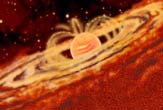
What exactly to call any of these objects and systems remains up in the air, however. But whatever the astronomers end up calling these Dark Stars (and I still think this is the best possible name) the fact is that they exist. A real blueprint for a Dark Star system has been observed, in interstellar space (5). Some astronomers want to call objects like these "planemos". Not very catchy, though, is is?
WISE on Target to find Nearby Brown Dwarfs
The hunt for brown dwarfs and other potential neighbours to the Sun is picking up speed. Spurred on by the exciting discoveries made by the Spitzer telescope in recent years, the scientists preparing the WISE launch are getting increasingly excited about what they might discover out there. It's just a case of who's going to find the Dark Star first...WISE, SIRTF or the Japanese? Either way, we're going to know within just a couple of years. Here's an extract from a recent press release from NASA:
"An estimated $300-million mission, the
Wide-field Infrared Survey Explorer, or "Wise," has been in the planning stages
for the past eight years. It is scheduled to launch into an Earth orbit in late
2009. It will spend seven months collecting data.
Such extensive sky coverage means the mission will find and
catalogue all sorts of celestial eccentrics. These may include brown dwarfs, or failed stars, that are
closer to Earth than Proxima Centauri, the nearest star other than our
sun. Brown dwarfs are balls of gas that begin life like stars but lack the mass
to ignite their internal fires and light up like normal stars. They do, however,
produce warm infrared glows that Wise will be able to see.
"Brown dwarfs are lurking all around
us," said Dr. Peter Eisenhardt, project scientist for the mission at
NASA's Jet Propulsion Laboratory, Pasadena, Calif. "We believe there are more
brown dwarfs than stars in the nearby universe, but we haven't found many of
them because they are too faint in visible light."
"Wright, Eisenhardt and other scientists recently identified
brown dwarfs using NASA's infrared Spitzer Space Telescope. Wise will vastly expand the search, uncovering those
brown dwarfs closest to Earth that might make ideal targets for future
planet-hunting missions. Recent Spitzer
findings support the notion that planets might orbit brown
dwarfs." (6)
Stardust's Enigma
Scientists looking into the secrets of the comet composition have been surprised to find that some of the complex minerals collected by the Stardust probe must have been formed elsewhere. Although the comet's origin, on the face of it, is in the coldest reaches of the Solar System, the minerals must have formed in the hottest parts of the early solar system.
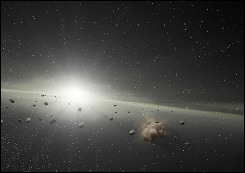
Here's a bit of blurb about some preliminary findings:
"Analysis of the large particles that travelled all the way to the button of the tracks has revealed a remarkable range of minerals. Some of these particles contain minerals the form only at extremely high temperatures - temperatures that could not have existed where the comets formed. Some of these minerals are similar to "refractory" materials that formed in the hottest, innermost regions of the disk of gas and dust that formed the Sun and planets. If these minerals in the comet are from our solar system then they probably formed close to the young Sun and were transported all the way from inside the orbit of Mercury past the orbit of Neptune.
Another option is that these "hottest minerals found in the coldest place" actually formed around other stars. The distinction between solar system and extra-solar origin of these minerals will be determined by measuring their isotopic compositions. The abundances of the isotopes of elements like oxygen is quite different in true stardust grains, formed around other stars, than it is for materials formed in our solar system. One of the most exciting outcomes of the workshop was preliminary data suggesting that the comet is a mix of both stardust grains from other stars as well as materials formed in the solar system. As expected, there appears to be true stardust in Stardust." (7)
Now, it's certainly plausible that the Sun has captured interstellar comets originating form other star systems. But it's also quite possible that the Stardust comet formed in another hot part of the solar system, i.e. in the proto-planetary disk of a brown dwarf companion. In such a circumstance it would naturally have isotopic compositions that reflected the binary nature of the solar system, which I suspect is what we're seeing here. It'll be interesting to see what the final analysis of these isotopic studies shows. My bet is that anomalous isotopic compositions will indeed be discovered in the cometary admixture, and that the anomalies will be consistent with the primordial disk of a very low mass star, or brown dwarf...
Lee Covino has been keeping an eye on the (lack of ) developments with results from the Deep Impact probe. As previously reported here, scientific findings from the mission have been hard to come by. Relating obliquely to this, Lee sent me an article about a Japanese space probe which is studying the composition of an asteroid. It has discovered that the asteroid was an amalgamation of debris from a previously shattered planet, or asteroid (8). It seems that all the asteroid belt objects may have similarly been sourced from an ancient planet or planets which had disintegrated during the period of the early solar system. Such a confirmation would, of course, take Sitchin's theories about the early solar system further forward.
Update 2008: A bizarre camera failure temporarily affected the latest probe's mission to study an asteroid. Rosetta's unexpected difficulties are in keeping with the possibility that initial data from these probes is being transferred to an agency, for analysis, prior to public release. Lee notes that scientists are already admitting to silica in these objects (9).
Imaged Dark Star sets another precedent
A known binary companion, orbiting its star at a distance of a whopping 16 times that of Neptune, has been imaged. This brown dwarf is comparatively cool, and will allow scientists to study the properties of the rare 'T' dwarfs. But, perhaps more importantly, the confirmed existence of such an object sets a remarkable precedent for a proposed binary companion around our own Sun. After all, the location of this object is comparable to my Dark Star proposal. It surely can no longer be argued that a brown dwarf could not form at such a distance from the Sun!
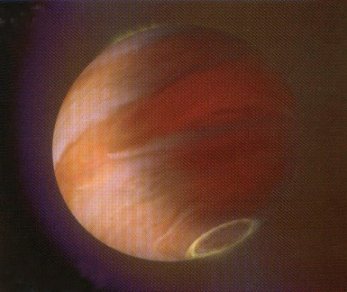
Indeed, does this not increase the likelihood that such objects are actually commonplace? That the majority of stars, including our own, have dark, cool companions in orbit around them at significant distances...
This latest discovery was found in the constellation of Pisces, at a very great distance from the solar system. The brown dwarf shines brightly enough to be imaged at this distance because it is currently very youthful. Give it a few million years and the young fires in this companion failed star will burn out, leaving it a dark ember in space. I suspect that this happens across the galaxy during the emergence of star systems. I believe that the clusters of new stars contain fields of planetary and sub-stellar objects intertwined with the larger stars. As the clusters break up, some brown dwarfs will remain as dark companions, whilst others will float freely in inter-stellar space.
Just in case you believed that our Sun was somehow created differently from this sort of scenario, new scientific thinking establishes the fact that the Sun was born in a cluster of stars, and that the Sun had sisters! (11) As such, it would seem no surprise to find out that our Sun has a remnant dark sub-stellar companion orbiting it at a great distance.
New Extremophiles Discovered
You'll have probably already heard about the
bacteria at the bottom of the ocean that thrives on geo-thermally heated lava
springs. This bacteria is not connected with the standard pattern of life
on Earth, which is built upon the heat and light of the Sun. Now there is
a new set of extremophiles to consider, this time existing at a great depth in
the Earth's crust. They point the way towards a new ecosystem existing
beneath the surface of the Earth, and quite possibly beneath the surface of
various other planets and moons in the Solar System. Which moves us
another step forward...
"Researchers have found what they
say are isolated bacterial colonies flourishing deeper in the Earth’s crust than
was known to be possible.
The
strange beings thrive on radioactive water, in a harsh setting cut off from
surface life and its dependence on sun energy, the scientists claim. That,
they add, raises hopes that other planets in our solar system could also harbour
hardy microbes within them. “We know surprisingly little about the origin,
evolution and limits for life on Earth,” said bio-geochemist Lisa Pratt of
Indiana University Bloomington, a member of the research team.
“Scientists are just beginning to
study the diverse organisms living in the deepest parts of the ocean. The rocky
crust on Earth is virtually unexplored at depths more than half a kilometre
below the surface. The organisms we describe in this paper live in a completely
different world than the one we know.”
The researchers argued that the bacterial communities they
found are permanent, apparently millions of years old, and depend on radiation
from uranium ores rather than sunlight. This raises the possibility that similar
bacteria could live beneath the surfaces of worlds such as Mars or Jupiter’s
moon Europa, the scientists said." (12, 13)
Planets form around tiny brown dwarfs
Marshall Masters sent me a link to a news story from last year which I hadn't come across before. It likely links in with more recent discoveries of planets actually found orbiting brown dwarfs in the Chamaeleon I star-forming region, although these latest discoveries are wide binaries rather than habitable-zone rocky planets. There's some juicy info in here, for sure, like the ratio of planet-mass to host brown dwarf:
"The discovery calls for a rethink of how diverse planetary systems can be, says Kevin Luhman of the Harvard-Smithsonian Center for Astrophysics in Cambridge, Massachusetts, US. "We always just think of planets forming around stars about the mass of our Sun," he says. "But they could form in more exotic situations around very small brown dwarfs - there might be mini solar systems out there." (14)
The lightweight brown dwarf, first identified five years ago, lies about 500 light years away in a star formation region called Chamaeleon I. Earlier observations revealed large amounts of water in its atmosphere.
The new observations by Spitzer clearly reveal signs of a disc around the dwarf, and suggest the inner rim of the disc lies about 700,000 kilometres from the dwarf's centre. Discs around brown dwarfs typically weigh about one-tenth of the mass of the star itself, so in this case it probably contains one or two Jupiter masses of available planet-building material. "I'd speculate that it could build a Saturn, or maybe a few smaller Earth-sized planets," says Luhman
What is more, these would-be planets could be habitable. The surface temperature of the mini brown dwarf is about 2000°C, which means that any planet 1.5 to 7 million kilometres away could maintain liquid water. The disc probably straddles this range.
Luhman hopes to find out whether even smaller objects - perhaps as little as five times the mass of Jupiter - can reign at the centre of nascent planetary systems. "It's still an open question as to how small you can go, but hopefully we'll be able to answer that soon."
"Spitzer really is a killer instrument for detecting this kind of object," says Andrew Collier Cameron, who studies extrasolar planets at St Andrews University, UK. He adds that the new result suggests brown dwarfs could prove to be fertile hunting grounds for planets, and it might be possible to image these planets directly - without being blinded by the glare that shines out from regular stars." (14)
Astronomers model 'binary' Solar System
Recent computer simulations have now proved that if the Sun had a binary companion, planets would still form around it. Complex and time-consuming calculations using mainframe computers have shown that a allowing for a wide binary stellar object does little to alter the structure of the planetary system that forms. As long as the binary companion stays beyond Saturn's orbit:
""The disk is modelled after the
Solar nebula," Quintana explains, "we're comparing the planet formation process
in these binaries to models of the Solar System." In other words, they are
trying to find out what our Solar system might have looked like if the Sun were
a binary star.
All of their simulations form at
least one planet, an encouraging result. It turns out that the most important
factor is the companion star's periastron, or point of closest approach to the
star with the disk. A companion that gets as close as the orbit of Saturn (about
10 times farther than the Earth from the Sun) removes very little material from
the inner disk, and even speeds up the process of planet formation by nudging
the planetesimals into different orbits from time to time. A companion star that
gets as close as Jupiter (about 5 times farther than the Earth from the Sun),
however, will limit planet formation to the hottest central regions.
"Over half of the binaries [in
astronomical surveys] are wide enough to allow planet formation in the habitable
zone of solar-type stars." Elisa Quintana [of NASA's Ames Institute]
concludes." (15)
Including ours?
Santa's Surprise Collision
That Kuiper Belt is doing its strange stuff again. Dr Mike Brown, that leading discoverer of outer solar system planets, has found a KBO shaped like a rugby ball. It may be on its way towards a close encounter with Neptune in the future, which may divert its path into the inner solar system. One can just imagine the god Neptune booting 2003 EL61 towards the rest of his team-mates in about 2 million years time. It would be quite something to score a drop-kick from the back of the pitch! Also, quite a kick is needed by Neptune: 2003 EL61 is about the same size as Pluto. (16)
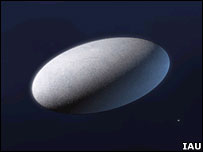
This unusual orbital behaviour is matched by the bizarre shape of this object. Speculation in the astronomical community is growing that 2003 EL61 (initially nicknamed 'Santa') was subject to a violent collision sometime in the past (17). The odds of such an event occurring in the Edgeworth-Kuiper Belt as it is known to exist today are very long indeed. The objects in the belt are simply too scattered to present any kind of risk to one another. Yet, this object appears to have taken a big knock, and may be on of a number of such objects in the belt.
"Flanked by two moonlets, 2003 EL61 measures
some 1,500 kilometers (950 miles) across, tumbling over and over at a prodigious
rate and pursuing a weird egg-shaped orbit inclined at nearly 30 degrees to the
plane at which almost all of the Solar System's objects travel.
"[Dr Michael] Brown's team found
five other rocks, measuring between 10 and 400 kilometers (six and 250 miles)
across, that they believe were smashed away from 2003 EL61 in the distant past.
The cluster shares the same colour and the light they reflect has a signature
that suggests they are covered with surface water ice." (17)
The astronomers speculate that the collision which sheared all of these smaller objects from 'Santa' took place around the time of the Earth's formation. Interesting, don't you think? It has to be said that the likelihood of that having happened is not very high...unless the Edgeworth-Kuiper Belt contained a great many more objects 4+ billion years ago. Add in a Dark Star to the equation and the whole scenario then makes much more sense...
Binary Stars can yield Planetary Systems
"Astronomers using NASA's Spitzer Space Telescope have observed that planetary systems – dusty disks of asteroids, comets and possibly planets – are at least as abundant in twin-star systems as they are in those, like our own, with only one star.
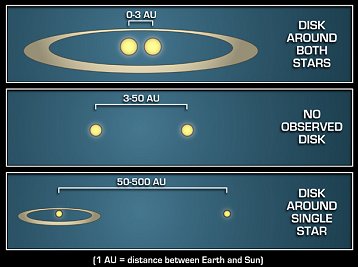
"Since more than half of all
stars are twins, or binaries, the finding suggests the universe is packed with
planets that have two suns. Sunsets on some of those worlds would resemble the
ones on Luke Skywalker's planet, Tatooine, where two fiery balls dip below the
horizon one by one.
"There
appears to be no bias against having planetary system formation in binary
systems," said David Trilling of the University of Arizona, Tucson, lead author
of a new paper about the research appearing in the April 1 issue of the Astrophysical Journal. "There could be countless
planets out there with two or more suns." " (18)
'New Earth' around Gliese 581
A red dwarf star some 20 light years from us has attracted the interest of astronomers searching for potential life-supporting planets. Gliese 581 has thrown up a new planet, this one lying within the system's planetary 'habitable zone'. Temperatures on this new planet are just right for liquid water to exist on the planet's surface. Where there's liquid water, there could be life.
Gliese 581 is much smaller than the Sun, so its habitable zone is much closer. The new planet lies just 6 million miles away from Gliese 581, and travels around the star in just 13 days. They lie so close together that the red Sun would appear massive in its sky.
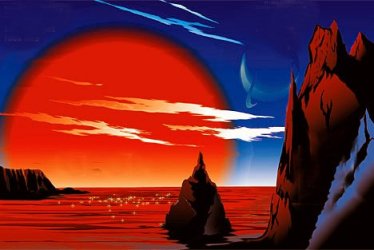
The illustration above appeared in the Daily Mail along with their article (19). Note the similarities in design between this last picture and my own painting of the Dark Star from the surface of one of its moons, a painting which appears on the cover of my book 'Dark Star' (below).
Nice to be making an impression amongst science journalists, finally!! This discovery adds further credence to the notion of habitable 'moons' orbiting dwarf stars, some of which are much more active and exotic than previously thought (see next item below).
The search for life seems destined to make its breakthrough amongst the dwarf stars. This is because smaller, Earth-sized planets are more able to be directly imaged and investigated when found orbiting around these smaller, dimmer stars, although the technology for this is several years away yet. Even so, the bookmakers William Hill have shortened the odds on proving the existence of extraterrestrial intelligence from 1,000-1 to 100-1.
Red Giant's Enormous Tail Stuns Astronomers
Here's a startling discovery that is important for my 'Dark Star Theory'. Stars with tails have deep symbolic meaning to those associated with the hunt for Planet X/Nibiru. Here's the story:
"A distant star that hurtles through space at extraordinary speeds has a huge, comet-like tail trailing in its wake, astronomers say.
The appendage, which measures a colossal 13 light years in length, was spotted by Nasa's Galaxy Evolution Explorer (Galex) space telescope. The researchers said that nothing like it had ever been spotted around a star. They believe the star, known as Mira, will help them to study what happens as stars meet their demise.
Mark Seibert, a co-author of the paper, which was published in the journal Nature, and a scientist at the Carnegie Observatories in Pasadena, said: "This is an utterly new phenomenon to us, and we are still in the process of understanding the physics involved."
Mira (also called Mira A) has captivated astronomers for more than 400 years. It sits about 350 light-years from Earth in a constellation known as Cetus, and is accompanied in orbit by a smaller secondary star, called Mira B, forming a binary system.
Billions of years ago, Mira would have been much like our Sun, but as it now enters its death-throes it has swollen into a type of star known as a red giant. As it races through space at 130km/s (80 miles per second) it sheds vast amounts of material. Yet despite centuries of study, its spectacular tail had remained undetected. Now, ultraviolet images taken by the Galex space telescope have uncovered Mira's unusual feature.
"The fact that Mira's tail only glows with ultraviolet light might explain why other telescopes have missed it." The ultraviolet images also revealed a "bow shock" - a region, in front of the star, where hot gas builds up as Mira's stellar wind meets clouds of interstellar gas and dust.
The team believes that the hot gas in the bow shock is heating up gas that the star is shedding to create a turbulent tail trailing in its wake. The scientists said that the tail was made up of the material that Mira has been ejecting over a period of 30,000 years." (20)
Sedna: Astronomers Suggest Jupiter-sized Perturber
One of my research associates sent me some fascinating academic material a while ago. Amongst the papers and forum debates is this paper written by some mainstream professors about the potential for a Jupiter-sized planet within the Oort Cloud.

I know I may seem a bit way out there with this Dark Star theory, but there are some serious astronomers who pondered the same ideas just last year. They were attempting to explain the strange trajectory of Sedna and other similar anomalous bodies (DDOs). Here's the abstract. For the full paper, click on the link below
"Most known trans-neptunian objects (TNO’s)
are either on low eccentricity orbits or could have been perturbed to their
current trajectories via gravitational interactions with known bodies.
However, one or two recently-discovered TNO’s are distant detached objects
(DDO’s) (perihelion, q > 40 AU and
semimajor axis, a > 50 AU) whose origins are not
as easily understood. We investigate the parameter space of a hypothetical
distant planetary-mass solar companion which could detach the perihelion
of a Neptune-dominated TNO into a DDO orbit. Perturbations of the giant
planets are also included. The problem is analyzed using two models.
"In the first model, we start with a
distribution of undetached, low-inclination TNO’s having a wide range of
semimajor axes. The planetary perturbations and the companion perturbation are
treated in the adiabatic, secularly averaged tidal approximation. This
provides a starting point for a more detailed analysis by providing insights as
to the companion parameter space likely to create DDO’s. The second model
includes the companion and the planets and numerically integrates perturbations
on a sampling that is based on the real population of scattered disk
objects (SDO’s).
"A single calculation is performed including
the mutual interactions and migration of the planets. By comparing these
models, we distinguish the distant detached population that can be attributable
to the secular interaction from those that require additional planetary
perturbations. We find that a DDO can be produced by a hypothetical Neptune-mass
companion having semiminor axis, b
</=2000 AU or a Jupiter-mass companion with b</= 5000 AU. DDO’s produced by such a
companion are likely to have small inclinations to the ecliptic only if
the companion’s orbit is significantly inclined. We also discuss the possibility
that the tilt of the planets’ invariable plane relative to the solar
equatorial plane has been produced by such a hypothetical distant planetary-mass
companion. Perturbations of a companion on Oort cloud comets are also
considered."
Written by Andy Lloyd, 2006-7
Author of 'The Dark Star' (2005), 'Ezekiel One' (2009), 'The Followers of Horus' (2010) and 'Darker Stars' (2018)
Published by Timeless Voyager Press
References:
1) Helen Briggs "Dwarf survives in stellar furnace" 2 August 2006
http://news.bbc.co.uk/1/hi/sci/tech/5235306.stm
2) National Optical Astronomy Observatory Noao press release (article on longer online)
3) BBC News "Strange New Twin Worlds Found" 3 August 2006
http://news.bbc.co.uk/1/hi/sci/tech/5241774.stm
4) McMaster University "Smashing young stars leave dwarfs in their wake" 9 June 2006
5) Robert Roy Britt "Strange New Worlds Could Make Miniature Solar Systems" 5 June 2006 with thanks to David Pearson and Phil Whitley
http://www.space.com/scienceastronomy/060605_planemos.html
6) Dr Brownlee, Stardust Principle Investigator, "Stardust Analysis Update"
http://stardust.jpl.nasa.gov/news/status/060512.html 12/5/06
7) University of Michigan "Floating Pile Of Rubble A Pristine Record Of Solar System's History" 2 June 2006 http://www.sciencedaily.com/releases/2006/06/060602073338.htm
9) ESA "Rosetta asteroid flyby reveals diamond in the sky" 6 Sept 2008
https://spaceflightnow.com/news/n0809/06rosetta/
10) Sam Savage "The Star, the Dwarf and the Planet: First Directly Imaged Brown Dwarf Companion to an Exoplanet Host Star" 19 October 2006
11) Robin Lloyd "In Formative Years, the Sun Had Sisters" 24 October 2006
https://www.space.com/3034-formative-years-sun-sisters.html
12) World Science "Strange, underworld microbes raise hopes for alien life" 19th October 06 (article on longer online)
13) Carnegie Institute "Otherworldly bacteria discovered two miles down" 20th October 2006
14) H. Muir "Brown Dwarf may someday harbour habitable planets" 8th February 2005
15) PhysOrg.com "Terrestrial Planet Formation in Binary Star Systems" 26 Jan 2007
http://physorg.com/news89031463.html
16) Paul Rincon "Dwarf planet 'becoming a comet': An unusual dwarf planet discovered in the outer Solar System could be en route to becoming the brightest comet ever known. " 17th January 2007
http://news.bbc.co.uk/1/hi/sci/tech/6268799.stm
17) PhysOrg.com "Kuiper-belt Object Was Broken up by Massive Impact 4.5 Billion Years Ago, Study Shows" 14th March 2007
http://physorg.com/news93105023.html
18) Whitney Clavin "Spitzer Finds Planets Thrive Around Stellar Twins" 29 March 2007
http://www.physorg.com/news94403553.html
19) Daily Mail "Found 20 light years away: the New Earth" 25th April 2007
20) "Colossal tail trails dying star" 15th August 2007 With thanks to Brian Forsyth
http://news.bbc.co.uk/2/hi/science/nature/6947607.stm
21) Rodney S. Gomes, John J. Matese, Jack J. Lissauer "A distant planetary-mass solar companion may have produced distant detached objects” Icarus 184 (2006) 589–601
http://www.ucs.louisiana.edu/~jjm9638/acm2005/YICAR7974.pdf
You
can keep informed of updates
by following me on Twitter:
Or like my Facebook Page:
https://www.facebook.com/darkstarandylloyd

![]()


